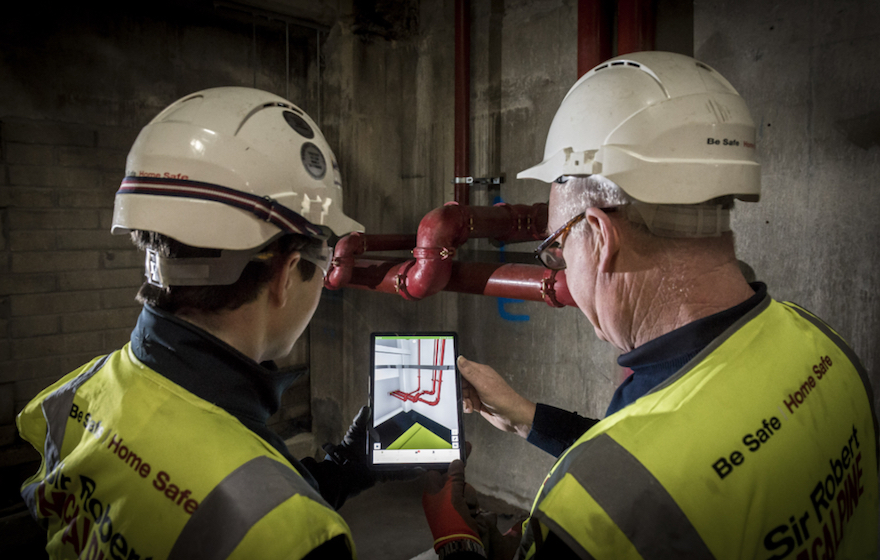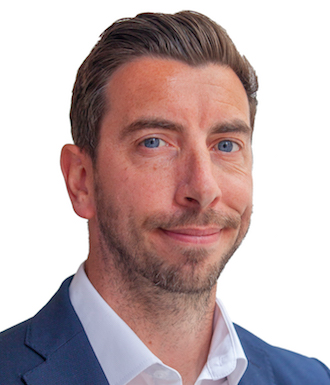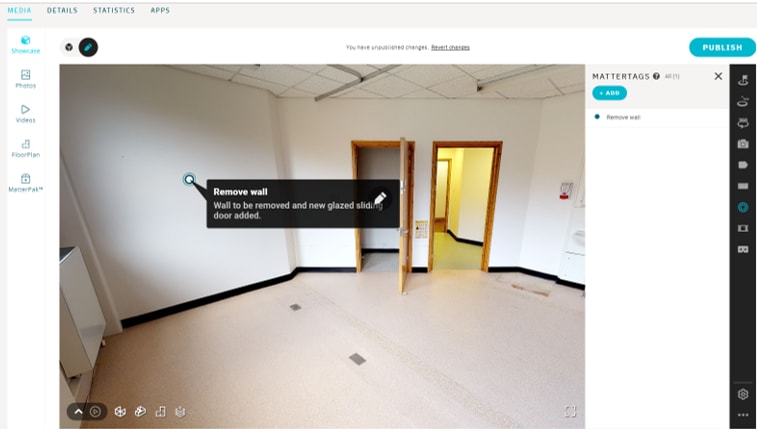
Better risk management, legal compliance and increased project efficiency are among the gains Sir Robert McAlpine is enjoying from a range of digital tools rolled out by the contractor over the last two years.
The technologies used include the Ricoh Theta 360-degree ‘fish ball’ camera lens for on-site photography, Disperse artificial intelligence (AI) technology to monitor installation progress, Matterport ‘walk through’ photogrammetry models to help project collaboration, and the Dalux smartphone app to boost engagement with site workers and subcontractors (see main image).
"These digital tools are supporting tasks that used to be executed manually, and the covid-19 working restrictions have accelerated their uptake," explains Sir Robert McAlpine strategic BIM and digital lead Nick Leach.
The Ricoh Theta has been introduced to the contractor’s projects over the last two years. The handheld device includes ultra-compact twin lenses at the front and rear of the camera that can take 360-degree images or footage.
"The use of the Theta and awareness of its capability has increased greatly among our workforce since we introduced it," says Leach. "The 360-degree lenses mean images can be captured all around you, not just in the direction the camera is pointing, enabling project teams to quickly and easily photograph and produce videos of different stages of progress, and completed sections before they get covered up. This helps our risk management and gives us a proof of record of what we have delivered.
"The Building Safety Bill legislation will force changes on the industry, as construction companies will have to get their information management in order, to demonstrate legal compliance. This kind of technology will be crucial to supporting and evidencing achievement of that."

We’ve proven that we can deliver work digitally, and efficiently, without having to print off reams of paper. Now we need to maintain these new digital work processes, as and when the pandemic passes, and not revert back to old habits.– Nick Leach, Sir Robert McAlpine
Photographs and footage captured by the Theta devices are also being uploaded to the cloud and analysed by AI technology through a product called Disperse, which Sir Robert McAlpine has introduced. The software aims to harmonise construction schedules, 2D drawings, 3D models and visual snapshots and processes them with its own proprietary AI. The company has been using Disperse on two projects so far with further projects identified.
"Footage taken by the Theta is uploaded, then quickly analysed by the Disperse solution and its unique identification technology. This tells us, for example, how installation is progressing against the construction programme, allowing us to quickly see and interrogate areas requiring further attention through the quick turnaround time reporting features it provides," Leach explains. "The more we use it, the software learns from itself and becomes even more effective."
Sir Robert McAlpine is also employing advanced camera technology from Matterport, which uses high definition photography to create 3D photogrammetry project models which users can ‘walk through’ in the style of Google Streetview. It styles itself as an immersive digital twin.
"Matterport allows us to utilise features such as taking site measurements, add labels and tag assets and equipment, which includes the ability to put in hyperlinks out to product manufacturers’ websites," Leach says. "One thing about Matterport that is really useful is our external partners don’t need to be a subscriber to access a model. We can use a Matterport project model and have the ability to share this with our clients, allowing them to have a virtual guided tour of the site, understand progress, and at completion deliver scans as a record of the project that can be integrated with our digital handover O&M solution."

Screen grab of the Matterport 3D photogrammetry in action
Site level workers on Sir Robert McAlpine’s projects are now accessing 3D models and other project information using smartphones and tablets, after the contractor introduced the Dalux BIM solution two years ago. It is now employed as "business as usual" across all the company’s projects, according to Leach.
Dalux helps construction workers understand and view architects’ and engineers’ intended designs when on site, with an augmented reality (AR) feature that allows comparison of the digital model with the physical reality. Leach sees it as an important tool for increasing digital engagement among project teams at site level.
"Dalux BIM is an important part of our armoury of tools," he says. "It fulfils a need required in our business for easily accessing construction models while outside on site through handheld devices.
"The integration of the 3D model with the AR functionality really helps our project teams. It enables understanding and communication of the design in relation to the real world state on site and provides an excellent visual means in supporting validation of the build process – both what is to be built and what has been installed compared in comparison to the intended design."
Covid-19 has accelerated digital adoption across the whole construction industry, and Sir Robert McAlpine is no exception says Leach. "We’ve proven that we can deliver work digitally, and efficiently, without having to print off reams of paper," he says. "Now we need to maintain these new digital work processes, as and when the pandemic passes, and not revert back to old habits."













